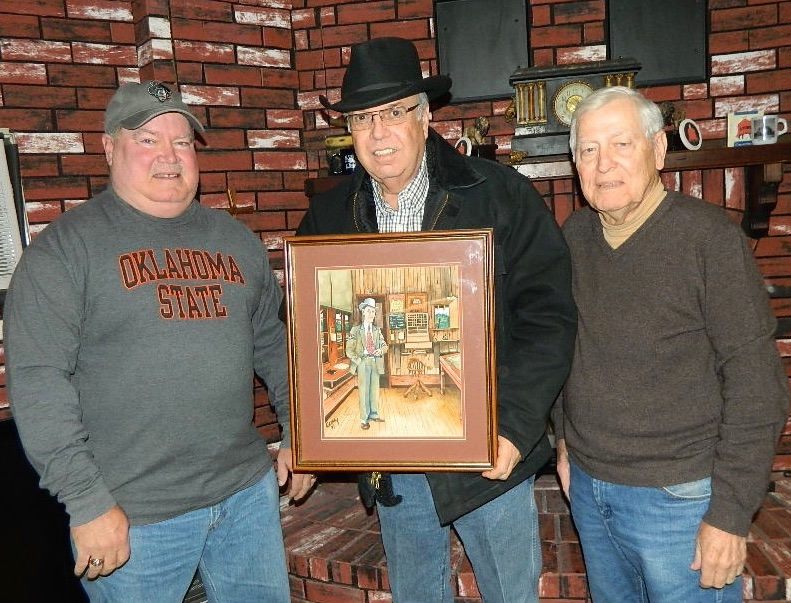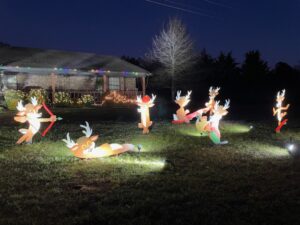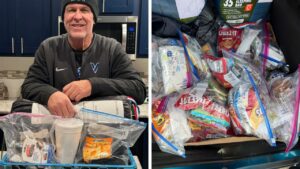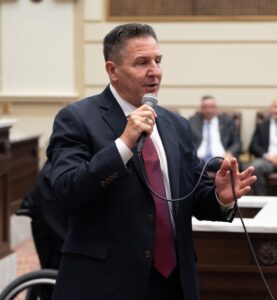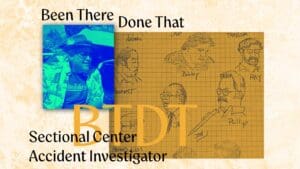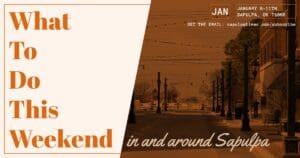It was nearly 40 years ago when Sapulpa artist Russell Crosby was approached by a co-worker about doing a painting of his grandfather. The result, a neat Christmas gift for mom and the capturing of an important and otherwise forgotten piece of railroad legacy.
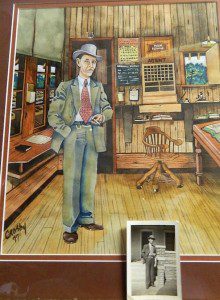
Craig Evans was a “gofer” for Liberty Glass at the time and Crosby was an accountant fot Tulsa-Sapulpa Union Railway. Both of those entities along with Red Ball were George Collins’ companies. The two young men worked together at the Collins Building (today’s Creek County Courthouse annex).
Evans, who carried mail and messages between the offices, had taken note of Crosby’s art talent and wondered if Crosby would consider painting a portrait of his mother’s father, Virgil Caywood, a long time rail station agent for the Rock Island Line throughout southern Kansas.
The one interest that Crosby may have loved as much as painting was railroads. So yes, he would be glad to do the artwork depicting Evans’ grandfather on the job as station agent at the Harrington, Kansas Rock Island Depot.
“I thought it would make a good Christmas present for my parents,” Evans recalled this past week as he and his father, Ted, met with Crosby for a picture. It was the first time Russell and Craig had seen each other since the painting was completed and presented 38 years ago.
The two agree that Crosby was probably paid $25 for his work.
“I remember it cost a lot more to have it framed than it did to have it painted — $150, I think,” Evans said.
The $25 fee for painting “with some built-in inflation” and the always higher cost of framing is “still about the same,” Crosby joked.
Today, as far as Evans is concerned the painting is priceless. Given to his mother on Christmas, 1977, it really meant a lot to her. The painting will either end up with Craig’s kids/grandkids or maybe at the Sapulpa Historical Museum if all parties agree.
Crosby had pretty well forgotten about the painting until one day he ran into Ted Evans at the Sapulpa Historical Museum. That’s where Ted works as a volunteer one day a week and where Russell is on the board and much involved.
Evans had Russell autograph and date the back of the art. On the front is the signature “Crosby ‘77”. But with or without the signatures, “you can always pick out Russell’s work.” Craig said. “It’s so realistic looking.”
(A good sampling of Crosby’s art is revealed at the Sapulpa Post Office wrap-around mural. His color and detail has been likened to that of Thomas Hart Benton, one of Crosby’s favorite artists of all time. See footnote at end. Crosby has been cited locally and statewide not only for his art and support of art, but for his community service.)
“All I did was give him a couple of black and white photos of my grandfather,” Evans said. “One was a close-up of his face and the other a snapshot of him standing. Russell didn’t see the depot. He did his research and we have this great painting.”
Craig’s mother Lavonne “Kay” died seven years ago come Valentine’s Day. She was the only girl of Caywood’s six children. Craig remembers his grandfather who had passed at the time of the painting.
Craig has two daughters and two step-children. Ted returned the painting to Craig so that it can be retained as part of the Caywood family legacy.
“His family was very much a railroad family. They were steeped in railroading,” Evans said. “I think it is important that the younger generations know about his (Caywood/s) contributions to the Rock Island Line.
But beyond the painting of Rock Island Station Agent Virgil Caywood, the man, Crosby’s brushstrokes capture the dignity and influence of the position itself.
We don’t have a full accounting of rail agent history in Sapulpa. Like the caboose and passenger trains themselves, they became non-existent around here in the late 60s or early 70s.
Thomas C. Adams was the first station agent and telegraph operator. He ordered the cars for freight, passengers and livestock. At first livestock was the main part of the rail delivery system. One bit of history says that the line lay dormant in the early days if cattle were not being shipped.
That had changed considerably by the time singing cowboy Gene Autry came to Sapulpa as the telegraph operator for Frisco. The rail agent in those days had his hands far too busy to take care of telegraphs. He was the main man at the depot as well as in high regard throughout the community. Trains were important and so was the man charged with making sure they ran on time and was loaded with people and freight.
“The local railroad station agent, was usually one of the big players in the community not only as a railroad representative but in civic affairs,” Crosby said.
Now gone “only to remain in our memories and old railroad photographs,” paintings like Crosby’s of Caywood on the Rock Island Line at Harrington, Kansas, offer a glimpse of the way it was in communities across America. “Every little town had a railroad depot and freight depot,” Crosby reflects. “The smells, the sounds, the trains, and the hustle and bustle of railroad transportation all around, and many wondering if they could someday take a ride on the train to see what’s on the other side of the hill.”
The last rail station agent in Sapulpa was Harry Cherry back when the railroad was the Frisco in the early 70’s. Crosby remembers working with him.
“Our TSU train crew employees always started the day exchanging paper work with him,” Crosby said of Cherry. “He was located over in the little tin building next to the tracks on the wye where the Old Harvey House and railroad station used to be.”
Usually a section gang was stationed out of most areas and lived in the community as well. Railroad employees were a large part of everyday community life.
“Now we deal with their predecessor BNSF (Burlington-Northern, SanteFe) via computer out of Fort Worth on paper work for the most part,” Crosby laments. “They still interchange with us with a local Crosby plans to retire this summer. He has been with TSU 42 years, and at its helm as long as anyone can remember. Although not the same as the old-time rail agent, Crosby would be close to filling that role.
“Another big change (in railroading) is the demise of coal shipments on rail and the replacement with crude oil,” Crosby notes.
There are a lot of changes:
- Diminished size of train crews all the way down to remote control outside locomotive cab, positive train control.
- Section workers have been displaced with track machines such as tampers, ballast and continuous welded rail laying machine.
- The demise of the caboose is just reflective of a sea change in the rail industry.
––
* Thomas Hart Benton, born in Neosho, Missouri, was a Regionalist artist from the 1930’s who painted many murals in government buildings over the years. He died in 1975. Another of the famous muralist of the 30’s was Grant Wood from Iowa, and the third in this group was John Stuart Curry from Kansas, They all painted similar subject matter of the country and times, but different styles. “I love Benton’s style of painting, and my style does resemble his somewhat,” Crosby says. Interesting enough my favorite Oklahoma artist was Charles Banks Wilson, who studied under Thomas Hart Benton for awhile. Wilson is Oklahoma’s greatest artist (to me). His style is much like Benton’s also, only maybe a little more realistic I guess. They just all know how to use color and I love their subject matter which was the USA and its everyday people. That to me it what America is all about.” When asked about his favorite artists, Crosby also tagged an instructor of his at NEO-A&M, Nick Calcagno. “He was an inspiration to me then, and remains so to this day. Unfortunately he has passed. He specialized more in Sculpture and did the Norseman statue there at NEO in Miami.” Then there is Alexander Hogue of University of Tulsa fame.
—
This story was republished with permission from The Sapulpa News And Views Facebook Page.

